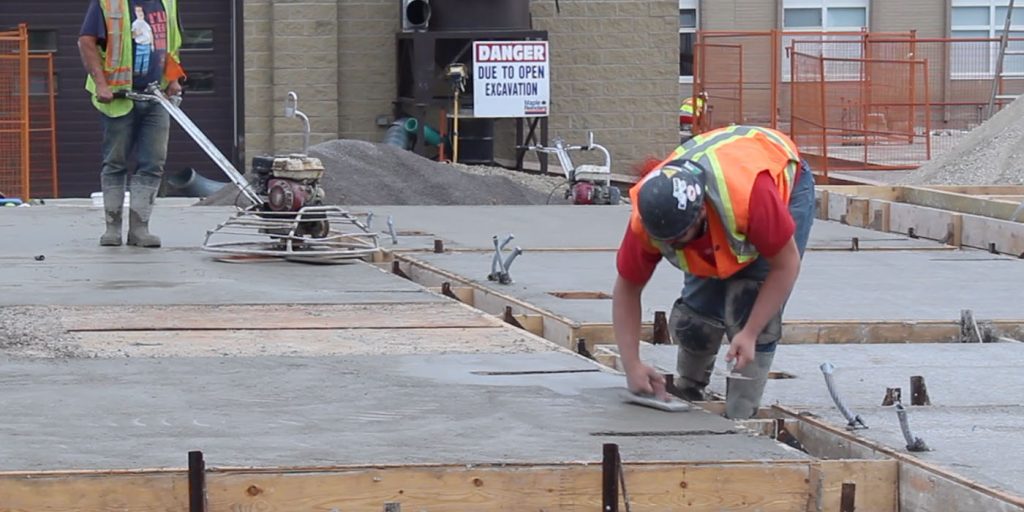
Tilt-up construction, (also known as tilt-slab or tilt-wall construction) is a construction technique where the concrete elements of the building (such as walls, columns, structural supports, etc.) are formed horizontally on a concrete slab and then raised into place once the concrete has cured.
Although this technique was founded more than a century ago, we see it as a re-emerging technology and one of the fastest growing solutions to construction needs,” says Stuart Galloway, President, Canadian Concrete Expo.
Tilt-up construction, (also known as tilt-slab or tilt-wall construction) is a construction technique where the concrete elements of the building (such as walls, columns, structural supports, etc.) are formed horizontally on a concrete slab and then raised into place once the concrete has cured.
Although this technique was founded more than a century ago, we see it as a re-emerging technology and one of the fastest growing solutions to construction needs,” says Stuart Galloway, President, Canadian Concrete Expo.
The technique is opposite to traditional construction, which builds vertically. It is a technique that, according to Len Overbeek, President, Tiltwall Ontario, is popular on both of Canada’s coasts but not in Ontario. “Atlantic Canada has been using tilt-up construction for a long time. The City of Vancouver is home to more than 50 tilt-wall contractors. There are only three tilt-up contractors in all of Ontario,” says Overbeek.
Founded in 2002, Tiltwall Ontario has built 60 buildings, including more than 1 million square feet of panel. Overbeek identifies five benefits tilt-up construction has over traditional construction that many people don’t know about.
- It is built with concrete
- It offers very different and beautiful forms
- It is safer than traditional construction
- Your concrete pump doesn’t have to fight gravity
- It provides significant energy efficiency cost savings
A tried and true building material
Concrete is the largest building material used in the world. Concrete is so durable, structures made of concrete can last decades or even centuries.
“Thomas Edison created a whole village using tilt-wall construction in 1908 that is still around today,” says Galloway.
Concrete is also plentiful; there are concrete plants all over populated areas of Canada.
“Within 48 hours of ordering concrete, you receive it,” says Overbeek. “For other building materials, you may have to wait weeks. That can delay your production schedule.”
Beauty is in the eye of the beholder
Often seen as grey and boring, a lot of people have turned away from concrete. However, since concrete is placed as a liquid, it can take any form, which means there are a lot of design possibilities.
“Tilt-up construction takes concrete and makes it beautiful. There are more than 200 formliners available; finishes for concrete have become endless,” says Overbeek. “The architect’s imagination is the only limit. If you say a concrete building that is grey and ugly, it is because someone lacked the imagination to design something beautiful.”
Tiltwall Ontario, for example, built a school that included 800 handprints of all the children who attended the school that year.
On a construction site, safety is paramount
Since 90 per cent of tilt-up construction happens on the ground, risks such as falling from heights and being struck from falling objects are nearly completely eliminated. Also, tilt-wall contractors report significantly fewer severe injuries and deaths.
When the panels of a tilt-up construction project are lifted into place, risk increases.
“We can brace to the interior or the exterior depending on which is possible and safer,” says Overbeek. “And, we do not remove braces until all the structural elements are in place.
No fighting gravity
Besides safety, building horizontally means that concrete pumps don’t have to be strained by the constant demand to push concrete up several storeys to be placed in its final position. With tilt-up construction, the concrete is placed at ground level so equipment can operate at a rate that won’t negatively affect its future performance.
“Also, the higher and faster you have to place the concrete, the more horsepower you need. More horsepower means a larger machine, which means a bigger machine footprint at the construction site and higher machine costs,” says Galloway.
Saving you money on energy costs
Tilt-up construction buildings are mass wall construction, which is any constructed structure that is at least 35 lbs/ sq.ft.
“Mass evens out energy demands,” says Overbeek. In our buildings, it is a continuous design; there are no spots where materials or structures start and stop, and this provides significant energy cost savings.”
Tiltwall Ontario works with a school board that has several schools that were built using tilt-up construction. One, built 22 years ago, when compared to the rest of the schools in the school board saves 25 percent on electric and 68 per cent on gas.
Similarly, a medical building constructed by Tiltwall Ontario is seeing significant energy cost savings. This 30,000-square-foot building has monthly gas bill on average of just $430. “Most people pay more to heat their homes,” says Overbeek.

